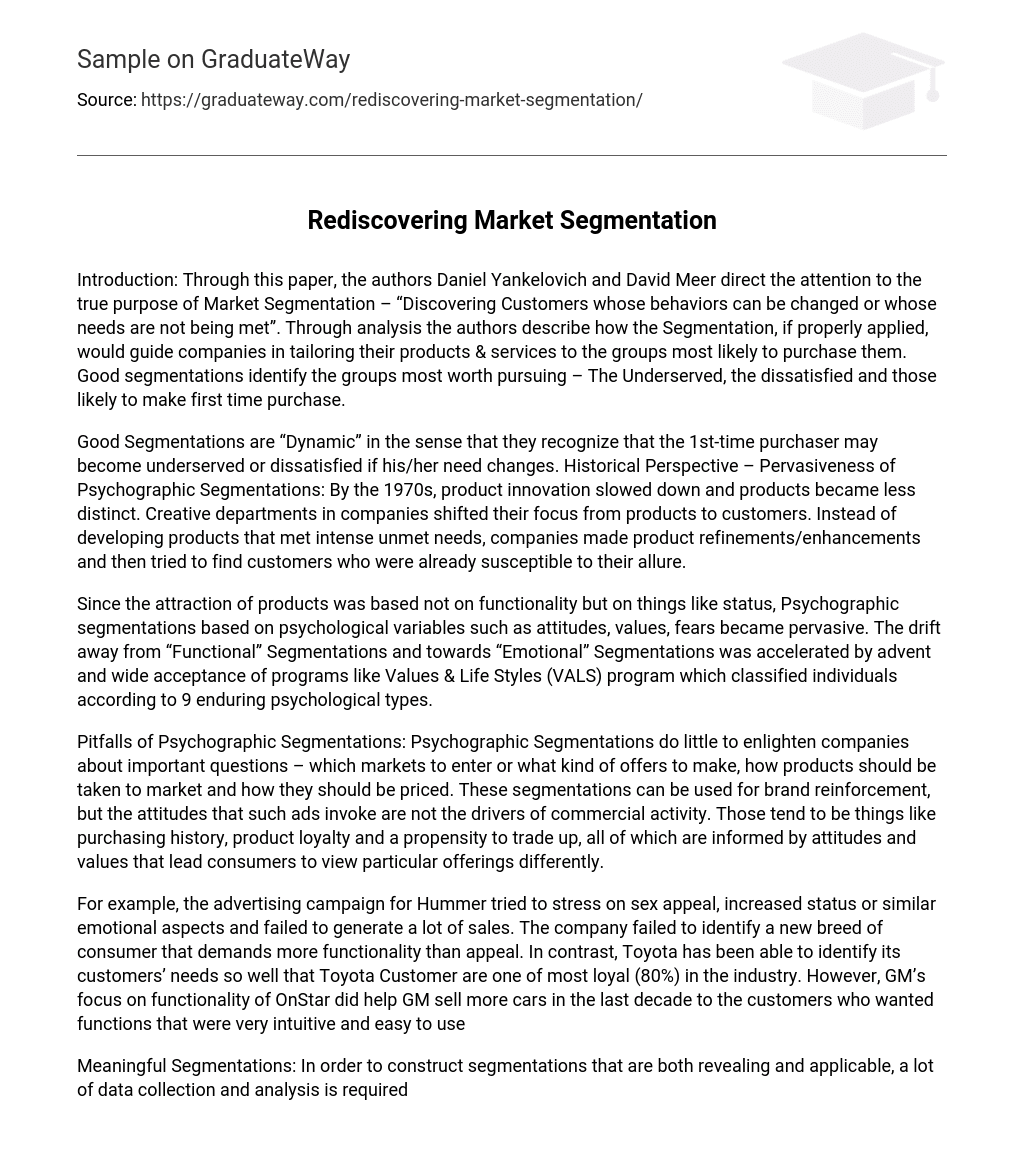In this paper, Daniel Yankelovich and David Meer emphasize the importance of Market Segmentation in discovering customers whose behaviors can be changed or whose needs are unmet. Good segmentations help companies tailor their products and services to the groups most likely to purchase them, such as the underserved, the dissatisfied, and those who may make their first-time purchase.
Good Segmentations are “Dynamic” in that they acknowledge that the initial buyer may feel underserved or dissatisfied if their needs change. A historical viewpoint reveals the wide usage of psychographic segmentations: in the 1970s, product innovation decreased and products became less unique. Within companies, creative departments turned their attention from products to customers. Rather than creating products that fulfilled significant unmet needs, companies made improvements and enhancements to existing products and then sought out customers who were already drawn to them.
Psychographic segmentations became popular as the attraction of products shifted from functionality to status. These segmentations were based on psychological variables such as attitudes, values, and fears. The rise of programs like Values & Life Styles (VALS) further contributed to the shift towards emotional segmentations. VALS classified individuals into 9 enduring psychological types, accelerating the shift away from functional segmentations.
Psychographic segmentations have limitations in providing insight to companies on crucial questions such as market selection, offer development, market strategy, and pricing. While these segmentations can be utilized to strengthen brand image, they do not strongly influence commercial behavior. Factors like purchasing history, product loyalty, and a predisposition to upgrade are more influential drivers, shaped by consumer attitudes and values that impact their perception of different products.
The advertising campaign for Hummer was focused on sex appeal, increased status, and emotional aspects. However, it did not succeed in generating high sales. The company failed to recognize that a new type of consumer desires more functionality rather than just appeal. On the other hand, Toyota has been successful in identifying its customers’ needs, resulting in a high level of loyalty among Toyota customers (80%). In contrast, GM’s emphasis on the functionality of OnStar did contribute to increased car sales in the past decade. This appealed to customers who wanted intuitive and user-friendly features.
Creating meaningful segmentations necessitates extensive data collection and analysis by companies. They must address several questions, including: What features are important to customers? Which customers are more willing to pay higher prices or seek lower ones? What advantages and disadvantages do customers perceive in current offerings? Are there any emerging social trends?
Meaningful Segmentations will:
-Reflect Company Strategy: Segmentations assist a company in addressing its strategic challenges by identifying groups of potentially interested or susceptible customers who are abundant and financially rewarding enough to warrant pursuing them. For instance, McDonald’s recent rise in profits can be attributed to its capability to identify a new segment desiring healthier menu options and devising appropriate strategies.
-Indicate sources of Profit/Revenue: Segmentations enable a company to comprehend the factors that contribute to the profitability of its top customers and subsequently target new customers who possess at least some of those characteristics.
The success of Obama’s campaign can be attributed to its ability to target young people (customers) through social networking. Companies can comprehend the changing needs of their customers by identifying their values, attitudes, and beliefs. In response to the evolving needs of its customers, Babies R Us decided to offer cleaning supplies. Meaningful segmentations involve analyzing factors such as heaviness of use, brand switching, retail format, or channel selection based on actual customer behavior. Apple demonstrated a comprehensive analysis of their customers’ behaviors when they introduced the iPhone with a different purchase model. Effective segmentations focus on consumers’ constantly changing needs, attitudes, and behaviors influenced by market conditions and predict changes in markets or behavior. Many fresh food stores chose to offer Organic Produce in order to respond to shifting consumer behavior and attract a market segment that would have otherwise chosen Whole Foods. Whole Foods caters to the needs of consumers who prefer locally grown produce by displaying the origin of their produce. Understanding the concept of the “gravity of decision” is crucial for marketers in relation to consumer behavior since it emphasizes the connection between consumers and a product or product category rather than other aspects such as jobs, friends, family, or community. Considering the significance of a consumer’s purchasing decision is important for effective segmentation purposes.Understanding the significance of a product or service to customers is crucial for a company to identify which customer expectations are indicators of their willingness to purchase. This segmentation process should aim to reveal information about buying and usage behavior, the willingness to pay more for better quality, and the level of brand loyalty. Moreover, it should also consider factors like consumers’ needs, social status, self-image, lifestyle, core values, and beliefs that influence their purchasing decisions. Ultimately, organizations that successfully implement segmentation strategies are better prepared to adapt in dynamic market conditions and gain valuable insights on how and where they can effectively compete with limited marketing resources.





